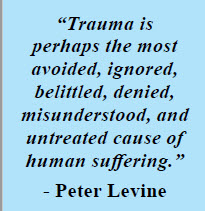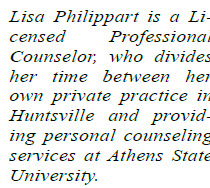 By: Lisa Philippart
By: Lisa Philippart
In recognition of October as Domestic Violence Awareness Month, I will be discussing the topic of traumatic bonds. In my next two articles, we’ll learn to recognize the signs of trauma bonding, and then discover how to break those traumatic bonds.
Leaving an abusive relationship usually isn’t as simple as walking out the door. In addition to the concerns about finding a place to live, supporting yourself, or being prevented from seeing your children or loved ones, you might feel tied to your partner, unable to break away. This emotional attachment, known as a trauma bond, develops out of a repeated cycle of abuse, devaluation, and positive reinforcement. The trauma of abuse might create powerful feelings, some of which you may struggle to make sense of, especially when abuse alternates with kindness and intimacy. It’s only natural to develop a bond with someone who treats you with affection and assurances of love. So, when the abuse begins, it may take you by surprise. Afterward your partner might apologize, promise to change, or insist that they were just “upset.” These attempts to manipulate often succeed, since you remember the early days of the relationship and believe they can be that person again. (Trauma bonding can also happen between a child and an abusive caregiver or other adult.)
 Trauma bonds can look a little different depending on the type of relationship, but they tend to have two main characteristics. First, trauma bonds depend on intermittent reinforcement—a cycle of abuse. It’s generally easier to leave a relationship or situation that is entirely bad, one where the abusive person never offers any compassion or concern for your wellbeing. If you don’t believe someone will ever change, you probably won’t stick around. But, in abusive relationships, your partner does periodically treat you well. They might bring you gifts, take you out, use gentle words, or urge you to relax. These gestures can be confusing and disarming, especially if thought of as signs that they might change. As you slowly regain a sense of trust, you might ignore memories of their past behaviors until the cycle begins again. The second main characteristic of trauma bonding is the power imbalance. In this dynamic, you might feel as if they control you to the point where you no longer know how to resist or break free. You might feel incomplete or lost without them and eventually return, simply because the abusive cycle is familiar, and you don’t know how to live without it yet.
Trauma bonds can look a little different depending on the type of relationship, but they tend to have two main characteristics. First, trauma bonds depend on intermittent reinforcement—a cycle of abuse. It’s generally easier to leave a relationship or situation that is entirely bad, one where the abusive person never offers any compassion or concern for your wellbeing. If you don’t believe someone will ever change, you probably won’t stick around. But, in abusive relationships, your partner does periodically treat you well. They might bring you gifts, take you out, use gentle words, or urge you to relax. These gestures can be confusing and disarming, especially if thought of as signs that they might change. As you slowly regain a sense of trust, you might ignore memories of their past behaviors until the cycle begins again. The second main characteristic of trauma bonding is the power imbalance. In this dynamic, you might feel as if they control you to the point where you no longer know how to resist or break free. You might feel incomplete or lost without them and eventually return, simply because the abusive cycle is familiar, and you don’t know how to live without it yet.
 Other characteristics of traumatic bonds include feeling unhappy and not even liking your partner any longer but feeling unable to end things. When you do try to leave, you feel physically and emotionally distressed. In fact, when you say you want to leave, the abusive partner promises to change but makes no effort to actually do so. Another trauma bond characteristic is fixating on the “good” days, using them as proof that your partner truly cares. You find yourself making excuses and defending their behavior when others express concern. Unfortunately, you continue to trust the offending person, hoping to change them. Often the abuser will encourage you to keep their behavior a secret, so you choose to protect them and yourself from “embarrassment.”
Other characteristics of traumatic bonds include feeling unhappy and not even liking your partner any longer but feeling unable to end things. When you do try to leave, you feel physically and emotionally distressed. In fact, when you say you want to leave, the abusive partner promises to change but makes no effort to actually do so. Another trauma bond characteristic is fixating on the “good” days, using them as proof that your partner truly cares. You find yourself making excuses and defending their behavior when others express concern. Unfortunately, you continue to trust the offending person, hoping to change them. Often the abuser will encourage you to keep their behavior a secret, so you choose to protect them and yourself from “embarrassment.”
Trauma bonds can linger, even when the abuse happened long ago. You might even struggle to stop thinking about someone who hurt you and feel the urge to reach out or try again. Here’s a test that might help you to understand whether you are struggling with a trauma bond: Ask yourself whether you’d encourage a loved one to leave a similar relationship. Answer yourself honestly. If you answer yes, but still feel powerless to leave your relationship, that’s a good indicator of trauma bonding.
By: Lisa Philippart
Licensed Professional Counselor






